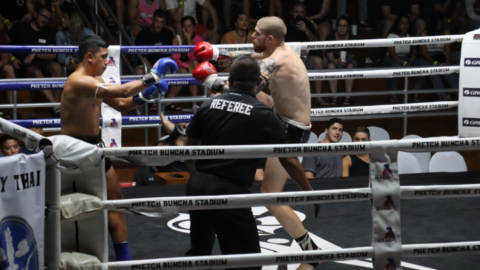Muay Thai: The Combat Sport Drawing Foreign Competitors to Thailand
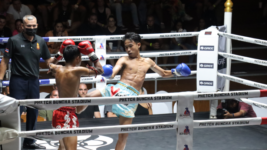
It was standing room only at the Phetch Buncha Muay Thai Stadium in Thailand’s Samui last Wednesday night, and the theme to 1976’s Rocky and Survivor’s Eye of the Tiger rang out on constant repeat as the crowd waited for the evening fights to begin.
Muay Thai translates as Thai boxing. The ancient Siamese combat sport is also known as the “art of eight limbs”, as it incorporates eight points of contact – fists, elbows, knees and feet – whereas as traditional western boxing only involves two points: the fists.
Inside the dressing room pre-fight, trainers were rubbing down their boxers’ bodies with Namman Muay, Thai boxing liniment oil, and attaching gloves to their hands, as well as giving the fighters pre-match pep talks.
That’s where I met Wit, who was about to take on Jocho in the night’s first fight. Wit is only 15, which is the youngest age a local can commence professional fighting. And his trainer, Manu, advises that Wit is still a student of the sport, and his 7 September 2022 fight is only his second.
Wit performed well in combat. He and his opponent did a lot of clinching. They both made it through the five 3-minute rounds that make up a match. Although, it was Jocho who ultimately won. And the second fight of the night, between two older Thai men, took place in a similar fashion.

“The greatest sport”
“Muay Thai is the greatest sport in the world because it teaches you respect,” kickboxer Marcin told Sydney Criminal Lawyers, in the dressing room prior to the commencement of the event. “It teaches you self-defence.”
“If you’re young and you have troubles – or even if you don’t have troubles – you should start Muay Thai because it’s a really great discipline,” the Polish man continued “It makes your character stronger every day.”
Marcin used to practice Muay Thai for many years. Then he stopped. But as he happened to find himself in Samui of late holidaying with some friends, he began training at a local gym and thought it was time to re-enter the ring.
The Polish kickboxer was waiting to take on Petch Kwanta, a local fighter who’s “fairly well known in Thailand”, in Wednesday night’s third fight.
And in terms of how Muay Thai contrasts to boxing in the West, Marcin explained, “In Muay Thai you can use kicking, knees, fists and the elbows, and there’s also clinching. In usual boxing you can only throw punches, so that’s the difference.”
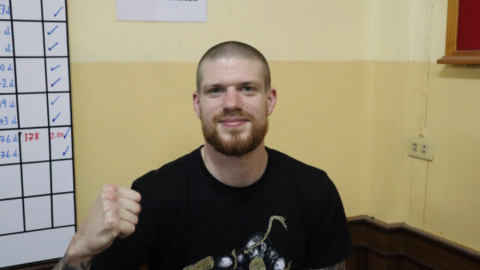
A brief history of Muay Thai
The origins of this Thai martial art can be traced back to the 13th century Sukhothai dynasty and the development of the first Thai army, with soldiers being taught both armed and unarmed combat, with the latter being Muay Thai.
One of the most renowned Muay Thai legends involves Nai Khanom Tom, who, in 1774, was being held in a Burmese prison, following that country having ransacked the Thai capital Ayutthaya.
The Thai kickboxer took on nine Burmese fighters whilst imprisoned in the neighbouring country, and on wining all the fights, he was granted his freedom as promised by the king.
Today, the Thai nation continues to celebrate the life of Nai Khanom Tom every year on 17 March, which is referred to as Muay Thai Day.
Since World War I, Muay Thai’s popularity has been growing around the globe. And while the sport permits a lot more moves than traditional western boxing, there are a number of strikes that were part of the original sport that are now banned as they can prove fatal.
A Muay Thai fight lasts five rounds. The fighters wear gloves and boxing shorts. The boxers appear in the ring wearing a Mongkhon, which is traditional sacred headwear. And the fighters walk to each corner of the ring and takes a bow pre-fight.
As is the case with Marcin, over the last half century, numerous western practitioners, or “nak muay farangs”, have taken up the sport. And these days, many Australians train at home prior to taking Muay Thai trips to Thailand to fight at the ubiquitous stadiums scattered across the country.
Knocked down in the first
The Muay Thai announcer called Marcin to the ring, and as he made his way, he was flanked by his trainer and friends. Then Petch Kwanta did the same. And both men took a bow at each corner of the ring, while the Thai man briefly performed a Ram Muay, or pre-fight dance.
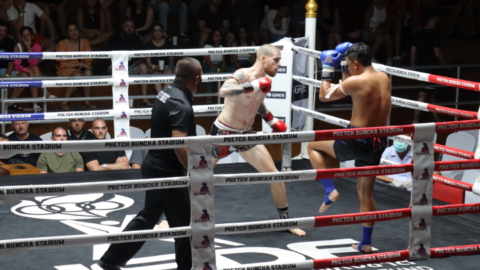
An official rang the bell to indicate the first round had started and the fighters moved towards the centre with gloves raised. And in a sign of what was to come, Marcin immediately kicked Petch in the right calf and the resulting sound was so loud it rang out through the stadium.
The pair then exchanged a number of punches, prior to Marcin kicking at Petch again, sending the Thai man stumbling backwards onto the floor, where he sat for some moments as the referee moved in between the pair ensuring the Polish man allowed his opponent to recover.
As Petch got back up onto his feet, what was about to happen was clear to the audience in the stands. And after a few more attempts at punching one another, Marcin landed another kick with his right foot, which knocked his opponent to the floor once more.
This time it was obvious Petch wouldn’t be getting back up. The referee walked over to Marcin, grabbed his right hand and raised it up to indicate the Polish man had won.
The fight was over in under three minutes.
Over before it started
Muay Thai is accompanied by a traditional Thai band that sits in a booth to the side of the stadium. Incorporating drums and wood instruments, the Samara music that’s played during the fights adds a trance-like element to proceedings.
Back in the change rooms after the match, Marcin is surrounded by his trainer and his group of friends, who all look pleased with the knockdown fight.
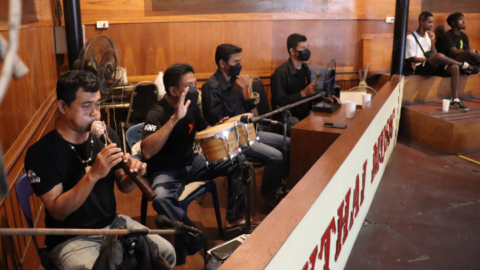
And as for how he’s feeling, the Polish man says he’s well, but he’d been looking forward to a fight that lasted a few more rounds.
“I was hoping for a longer fight but my opponent couldn’t get up,” Marcin said. “So, I won but it’s not like I’m proud of it.”
“The stress that I went through in the dressing room beforehand was much worse than the whole fight. That’s the thing.”
